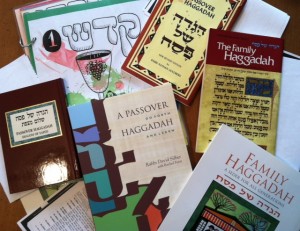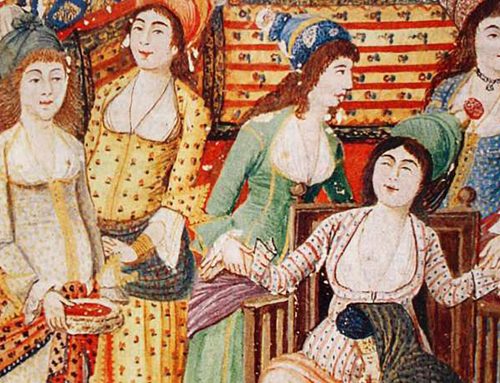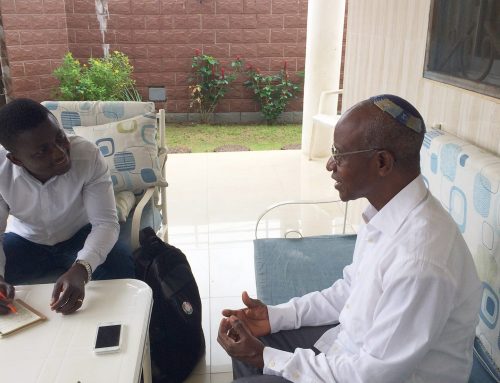
Texts upon texts: a cornucopia of haggadot. Photo by Hannah Pressman.
Thanks, Hannah. When it comes to haggadot, there’s functionality and then there’s functionality…
Personally, I love some of the design elements of the New American Haggadah, and I look forward to discussing them with you in the next round. However, surveying its usefulness “between a bowl of hardboiled eggs and a dish of macaroons,” as you put it, I think this book feels clunky. I’m imagining the neck strain that would come from trying to read the commentary pages sideways; maybe the editors needed an ergonomics consultant! And for a big hard-cover book like this on a crowded table, I have visions of spilled wine… although perhaps it would blend into the bleeding text images, who knows.
On the other hand, I think this book has incredible potential as a seder resource. I have powerful memories from my childhood of sitting up late on the night before the seder with my dad, a dozen or more haggadot strewn across the bed or the kitchen counter before us. We’d flip through, looking for interesting material, and would compile a cut-and-paste supplemental packet of readings and songs. Despite the fact that we used one of the most plain and boring haggadot of all times as our basis, I remember these seders as eclectic and stimulating.
After perusing this new haggadah over the past week, I’ve found plenty of content to sink my teeth into, including lots of readings that I’m sure will make it into my dad’s packet in years to come! On top of four cups of wine, four children, and four questions, we now have four commentators. My personal favorite is the “House of Study,” which introduces other Jewish texts (from midrashim to kabbalah) into the seder discourse. I also think the “Playground” commentary lives up to its fun title – Lemony Snicket (Daniel Handler)’s voice is fresh and snarky… perfect for after you’ve already downed a couple glasses of wine!
If you want to get the flavor of the four commentaries without reading the whole book, I’d recommend starting in with the set of essays about Elijah the Prophet (pages 104-105), which introduces a set of themes ranging from miracles to vengeance to the role of the stranger. Also, I especially loved the essays about Chad Gadya (pages 146-147), which have already enriched my understanding of why we end the seder with a seemingly silly song about a goat!
Lastly, as a Hebrew text geek, I love the way Foer and Englander play with font size and bolding, in order to emphasize (what they think are) the most important themes in each section. That in and of itself would be interesting food for thought at a high-level seder. Unfortunately, however, this game would only be fun for the Hebrew-literate; sadly they don’t play with the English text in the same way. Nor do they offer any transliteration, anywhere in the book. (Good thing you asked me about the book’s functionality and not about its accessibility to the uninitiated, or I would really go off!)
I too have more thoughts about this book, and especially about its translation and design, but I’ll turn it back over to you, Hannah, for the next round.
For the previous installment of the Stroum Center’s debate over the Foer/Englander Haggadah, click here.







Leave A Comment